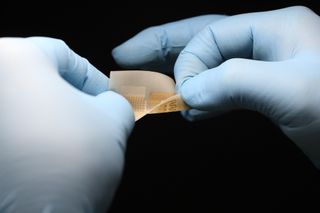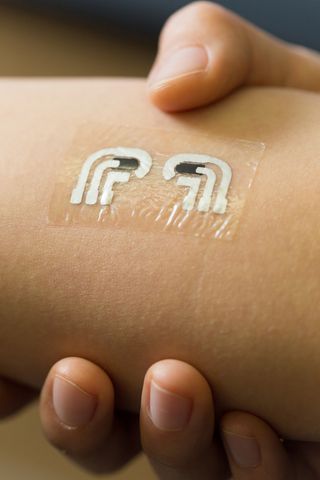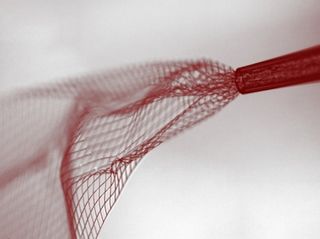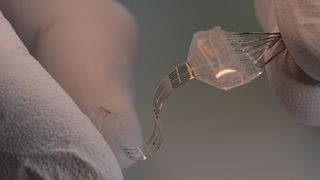
Body Bioelectronics: 5 Technologies that Could Flex with You

No more tough breaks. As "smart" electronics get smaller and softer, scientists are developing new medical devices that could be applied to — or in some cases, implanted in — our bodies. And these soft and stretchy devices shouldn't make your skin crawl, because they're designed to blend right in, experts say.
We want to solve the mismatch between rigid wafer-based electronics and the soft, dynamic human body, said Nanshu Lu, an assistant professor of aerospace engineering and engineering mechanics at the University of Texas at Austin.
Lu, who previously studied with John Rogers, a soft-materials and electronics expert at the University of Illinois Urbana-Champaign, focuses her research on stretchable bioelectronics. Lu and her colleagues have invented a cheaper and faster method for manufacturing electronic skin patches called epidermal electronics, reducing what was a multiday process to 20 minutes. [Bionic Humans: Top 10 Technologies]
Lu spoke with Live Science about emerging bioelectronics that are smart and flexible enough to essentially meld with the human body. From the latest advancements in smart tattoos to injectable brain monitoring to stretchable electronics for drug delivery, here are five fascinating technologies that could soon be on (or inside) your body.
Smart temporary tattoos
"When you integrate electronics on your skin, it feels like part of you," Lu said. "You don't feel it, but it is still working." That's the idea behind "smart" temporary tattoos that John Rogers and his colleagues are developing. Their tattoos, also known as biostamps, contain flexible circuitry that can be powered wirelessly and are stretchy enough to move with skin.
These wireless smart tattoos could address clinically important — but currently unmet — needs, Rogers told Live Science. Although there are numerous potential applications, his team is focused now on how biostamps could be used to monitor patients in neonatal intensive care units and sleep labs. MC10, the Massachusetts-based company Rogers helped start, is conducting clinical trials and expects to launch its first regulated products later this year.
Sign up for the Live Science daily newsletter now
Get the world’s most fascinating discoveries delivered straight to your inbox.

Skin-mounted biochemical sensors
Another new body-meld technology in development is a wearable biochemical sensor that can analyze sweat through skin-mounted devices and send information wirelessly to a smartphone. These futuristic sensors are being designed by Joseph Wang, a professor of nanoengineering at the University of California, San Diego, and director of the Center for Wearable Sensors.
"We look at sweat, saliva and tears to provide information about performance, fitness and medical status," Wang told Live Science.
Earlier this year, members of Wang's lab presented a proof-of-concept, flexible, temporary tattoo for diabetics that could continuously monitor glucose levels without using needle pricks. He also led a team that created a mouth-guard sensor that can check levels of health markers that usually require drawing blood, like uric acid, an early indicator for diabetes and gout. Wang said the Center for Wearable Sensors is pushing to commercialize these emerging sensor technologies with the help of local and international companies.
Nanomaterial drug delivery
Dae-Hyeong Kim, an associate professor of chemical and biological engineering at Seoul National University in South Korea, and his colleagues are pursuing nanotechnologies to enable next-generation biomedical systems. Kim's research could one day yield nanomaterial-enabled electronics for drug delivery and tissue engineering, according to Lu. "He has made stretchable memory, where you can store data on the tattoo, " she said. [10 Technologies That Will Transform Your Life]
In 2014, Kim's research group made a stretchable, wearable electronic patch that contains data storage, diagnostic tools and medicine. "The multifunctional patch can monitor movement disorders of Parkinson's disease," Kim told Live Science. Collected data gets recorded in the gold nanoparticle device’s memory.
When the patch detects tremor patterns, heat and temperature sensors inside it release controlled amounts of drugs that are delivered through carefully designed nanoparticles, he explained.

Injectable brain monitors
Although implantable technology exists for monitoring patients with epilepsy or brain damage, Lu pointed out that these devices are still sharp and rigid, making long-term monitoring a challenge. She compared soft brain tissue to a bowl of tofu constantly in motion. "We want something that can measure the brain, that can stimulate the brain, that can interact with the brain — without any mechanical strain or loading," she said.
Enter Charles Lieber, a Harvard University chemistry professor whose research group focuses on nanoscale science and technology. His group's devices are so small that they can be injected into brain tissue through a needle. After injection, nanoscale electronic mesh opens up that can monitor brain activity, stimulate tissue and even interact with neurons. "That," said Lu, "is very cutting edge."
Long-term implantable devices

Stéphanie Lacour and Grégoire Courtine, scientists at the École Polytechnique Fédérale de Lausanne's School of Engineering, announced in early 2015 that they had developed a new implant for treating spinal cord injuries. The small e-Dura device is implanted directly on the spinal cord underneath its protective membrane, called the dura mater. From there, it can deliver electrical and chemical stimulation during rehabilitation.
The device's elasticity and biocompatibility reduce the possibility of inflammation or tissue damage, meaning it could stay implanted for a long time. Paralyzed rats implanted with the device were able to walk after several weeks of training, the researchers reported in the journal Science.
Lu called e-Dura one of the best-functioning, long-term implantable flexible stimulators. "It shows the possibilities of using implantable, flexible devices for rehabilitation and treatment," she said.
Meanwhile, technologies that replicate human touch are growing increasingly sophisticated. Stanford University chemical engineering professor Zhenan Bao has spent years developing artificial skin that can sense pressure and temperature and heal itself. Her team's latest version contains a sensor array that can distinguish between pressure differences like a firm or limp handshake.
Lu said she and her colleagues in this highly multidisciplinary field hope to make all wafer-based electronics more epidermallike. "All those electronic components that used to be rigid and brittle now have a chance to become soft and stretchable," she said.
Follow us @livescience, Facebook & Google+. Original article on Live Science.
